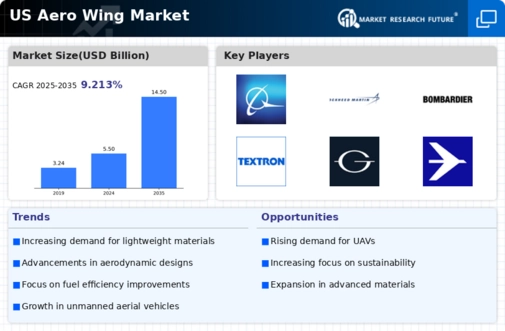Growth in Commercial Aviation
The aero wing market is poised for expansion due to the robust growth in the commercial aviation sector. As air travel demand continues to rise, airlines are investing in new aircraft to accommodate increasing passenger numbers. The Federal Aviation Administration (FAA) projects that the number of passengers traveling by air will reach 1 billion annually by 2026. This surge in demand necessitates the development of new aircraft models, which in turn drives the need for innovative wing designs. The aero wing market industry is likely to see increased orders for wings that enhance performance, reduce weight, and improve fuel efficiency. Additionally, airlines are focusing on fleet modernization to remain competitive, further propelling the demand for advanced aero wing technologies. This growth trajectory suggests a favorable outlook for the aero wing market industry in the coming years.
Increased Military Expenditure
The aero wing market is significantly influenced by the rising military expenditure in the United States. With a focus on enhancing national security and modernizing military fleets, the Department of Defense is investing heavily in advanced aircraft technologies. This includes the development of next-generation fighter jets and unmanned aerial vehicles (UAVs), which require sophisticated wing designs for optimal performance. In 2025, military spending is projected to reach approximately $800 billion, with a substantial portion allocated to aerospace and defense sectors. This increase in funding is likely to stimulate demand for advanced aero wing technologies, as military applications often necessitate cutting-edge aerodynamic features. Consequently, the aero wing market industry stands to benefit from this trend, as manufacturers align their offerings with the evolving needs of military aviation.
Rising Demand for Fuel Efficiency
The aero wing market is experiencing a notable surge in demand for fuel-efficient designs. As airlines and manufacturers strive to reduce operational costs, the focus on aerodynamic efficiency becomes paramount. Innovations in wing design, such as winglets and advanced materials, contribute to improved fuel economy. According to recent data, fuel costs account for approximately 30% of an airline's operating expenses. Consequently, the aero wing market industry is likely to see increased investments in research and development aimed at enhancing fuel efficiency. This trend is further supported by consumer preferences for environmentally friendly travel options, which may drive airlines to adopt more efficient aircraft designs. As a result, the aero wing market industry is poised for growth, with manufacturers prioritizing innovations that align with these economic pressures.
Environmental Regulations and Standards
The aero wing market is increasingly influenced by stringent environmental regulations and standards imposed by government agencies. As concerns over climate change and emissions intensify, regulatory bodies are establishing guidelines that require aircraft manufacturers to reduce their environmental impact. The Federal Aviation Administration (FAA) and the Environmental Protection Agency (EPA) are actively working to implement policies that promote sustainable aviation practices. This regulatory landscape is likely to drive innovation in the aero wing market industry, as manufacturers seek to develop wings that comply with new emissions standards. The push for greener technologies may lead to the adoption of alternative materials and designs that minimize environmental footprints. Consequently, the aero wing market industry is expected to evolve in response to these regulatory pressures, fostering a culture of sustainability within the aviation sector.
Technological Integration in Aircraft Design
The aero wing market is being shaped by the integration of advanced technologies in aircraft design. Innovations such as computer-aided design (CAD) and computational fluid dynamics (CFD) are revolutionizing the way wings are engineered. These technologies allow for more precise modeling and testing of aerodynamic properties, leading to enhanced performance and efficiency. The aero wing market industry is likely to benefit from these advancements, as manufacturers adopt cutting-edge design tools to create wings that meet the evolving demands of the aviation sector. Furthermore, the incorporation of smart materials and sensors into wing designs may provide real-time performance data, enabling continuous optimization. This trend indicates a shift towards more sophisticated and responsive wing technologies, which could redefine standards in the aero wing market industry.

















Leave a Comment